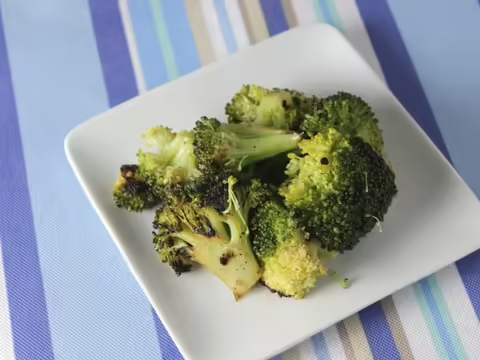Preparing Broccoli
Nutritional Value and Health Benefits of Broccoli
A member of the cabbage family and a close relative of cauliflower, broccoli packs more nutrients than any other vegetable. Broccoli contains large amounts of vitamin C and beta carotene which are important antioxidants. In the United States, broccoli has become the most favored cruciferous vegetable (cauliflower, Brussels Sprouts, and all forms of cabbage).
Researchers have concluded that broccoli and other cruciferous vegetables should be included in the diet several times a week. Consuming foods high in antioxidants can reduce the risk of some forms of cancer and heart disease. One half cup cooked broccoli contains the following nutrients as well as many other trace nutrients and phytochemicals.
Nutrition Facts
1/2 cup cooked fresh broccoli
- Calories: 23
- Dietary fiber: 2.4 grams
- Protein: 2.3 grams
- Carbohydrates: 4.3 mg
- Beta carotene
- Vitamin C: 49 mg
- Folic Acid: 53.3 nanograms
- Calcium: 89 mg
- Iron: 0.9 mg
Preparation and Serving
Wash broccoli under cool running water. Never allow it to sit in water as it will lose water soluble nutrients. Fresh broccoli is delicious raw or cooked. Trim and peel the stalk, it is high in fiber. Cut the florets into uniform pieces for even cooking. Overcooked broccoli develops a strong sulfur odor. Steam broccoli for 3-4 minutes or simmer in about one inch of boiling water for the same amount of time or less. Cooked broccoli should be bright green and tender-crisp. Overcooked broccoli turns dark green and suffers nutrient loss, especially vitamin C.
Home Preservation
Freezing is the best way to preserve broccoli. Broccoli, as well as all other broccoli vegetables, must be blanched (scalded) in boiling water before freezing. Unblanched vegetables contain an active enzyme which causes toughening and severe flavor and nutrient loss during freezing. Blanching retards the enzyme activity.
Freezing does not improve the quality of any vegetable. Freezing actually can magnify undesirable characteristics. For instance woodiness in stalks become more noticeable upon thawing. Select broccoli that has grown under favorable conditions and prepare for freezing as soon after picking as possible. Broccoli at its peak quality for eating will produce best results in the freezer.
- In a blanching pot or large pot with a tight fitting lid, bring 5 quarts of water to a rolling boil.
- Meanwhile, wash broccoli, trim stalks and cut through florets so that pieces of heads are not more than 1 inch across. Peel stalks and cut into rounds or quarter lengthwise.
- Blanch no more than one pound at a time. Add broccoli to boiling water and immediately cover with a tight fitting lid.
- Start timing immediately and blanch for four minutes.
- Prepare an ice water bath in a large 5-quart container or the sink.
- Remove broccoli from water with a slotted spoon or blanching basket.
- Emerge in the ice water bath for five minutes or until cooled. If you do not have ice, use several changes of cold water or running cold water. Remove and drain.
- Pack cold broccoli in zip-closure freezer bags or freezer containers. Squeeze out as much air as possible before sealing bags.
- Label and date each container or bag. Immediately place in the freezer, allowing an inch of space around each container until it is frozen. Freeze for up to one year at 0 degrees F. or below.
Blanching water can be reused. Add more water if necessary. Remember to always bring water back to a rolling boil before blanching more broccoli.
Flavor Enhancements
Herbs and spices that enhance the flavor of broccoli include basil, dill, garlic, lemon balm, marjoram, oregano, tarragon and thyme.
